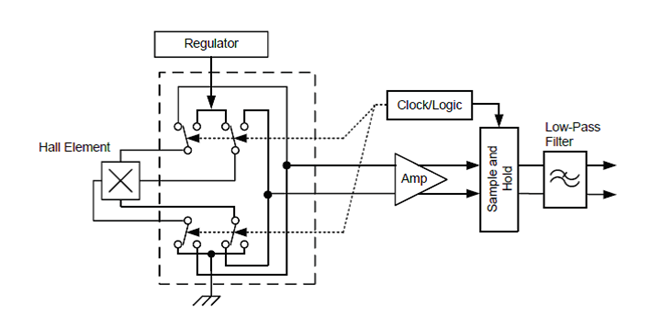Chopper Stabilization
A limiting factor for Hall sensor accuracy is the small signal voltage developed across the Hall element. This voltage is disproportionally small relative to the offset that can be produced at the output of the Hall element. This makes it difficult to process the signal while maintaining an accurate, reliable output over the specified operating temperature and voltage ranges. Chopper stabilization is used to minimize Hall offset on the chip. (The performance specifications for Allegro sensor ICs are typically guaranteed across their entire operating voltage and temperature ranges.)
The Allegro chopper stabilization technique, Dynamic Quadrature Offset Cancellation (U.S. Patent No. 5621319, 1997, now expired), removes key sources of the output drift induced by thermal and mechanical stresses. This offset reduction technique is based on a signal modulation-demodulation process. The undesired offset signal is separated from the magnetic field-induced signal in the frequency domain. This is illustrated in Figure 1.

Figure 1. Block diagram of chopper-stabilized Hall sensor
Dynamic Quadrature Offset Cancellation desensitizes the chip to the effects of thermal and mechanical stresses, producing devices that are extremely stable during and after temperature cycling.
The time-domain repeatability of magnetic field-induced switching can be affected slightly by chopper stabilization. However, the Allegro high-frequency chopping approach minimizes the effect of jitter and makes it imperceptible in most applications. (For a comparison of modern, chopper-stabilized Hall-effect switches to older, continuous-time devices, see our Continuous-Time to Chopper-Stabilized Cross-Reference Guide